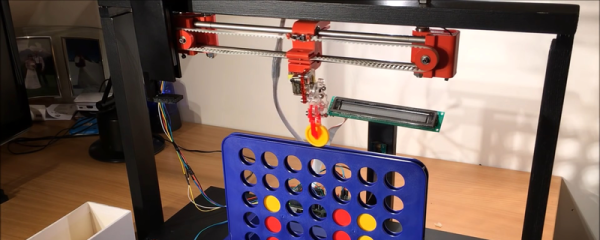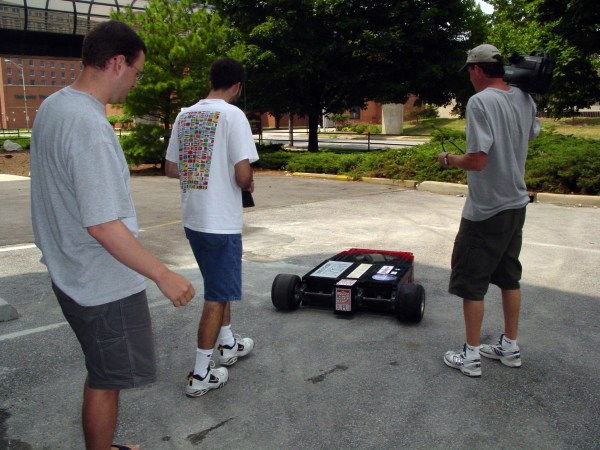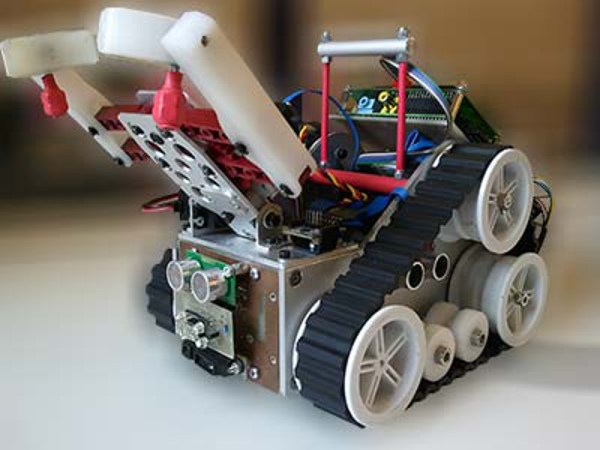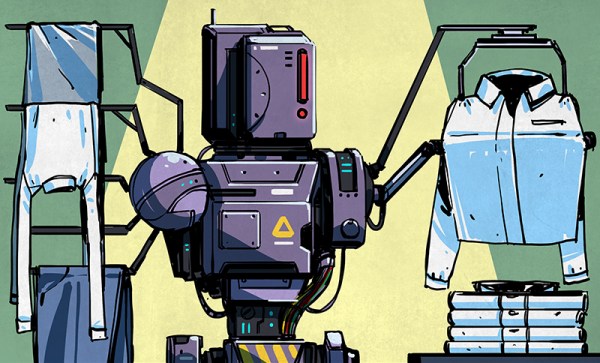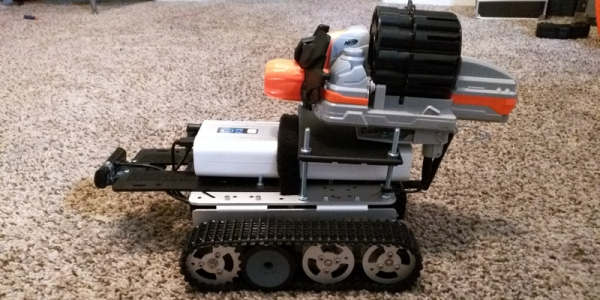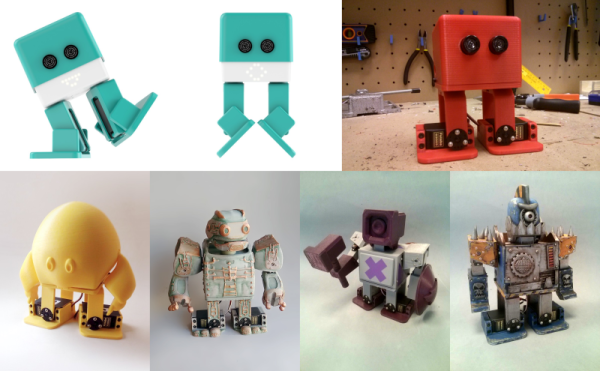Most people play games for entertainment. Hackers build robots to play games for entertainment. That’s what [piandchips] did. He used a Raspberry Pi and a MeArm kit to build a Connect 4-playing robot. The robot–named 4-Bot–has to do two things: the first is it has to be able to manipulate the pieces. Secondly, it has to be able to see the board. The MeArm imbues 4-Bot with the manipulation ability, and a clever scanning system does the trick.
robot1002 Articles
Paydar: What It Was Like To Battle Bots In 2002
Most people remember when Battle Bots was a big thing, but few of us got to live it as seen in this gallery. Every now and then, someone posts something more amazing than usual in the comments. When [Wolf] was studying at IUPUI they somehow convinced a professor to let them build a scary dangerous robot maiming device for their final project. It’s a cross-disciplinary project — even the medical students may get to participate.
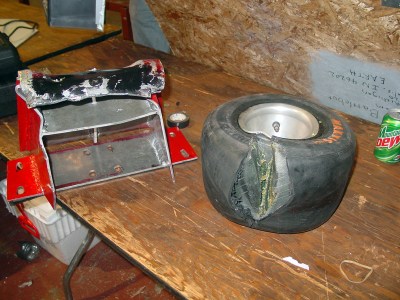
Their bot, unfortunately, got taken out by some spikes after attempting to get a spinbot before it started spinning and got them. If you look closely at the 2002 Comedy Central Battlebot opening you can see the smoke pour from their robot as they try to escape the fatal spikes.
The robot itself is a three wheeled design. The two wheels across from each other drive the robot, and the third steers. There is a very cool encoder mechanism for the steering wheel that is worth checking out. The main drive motor is a hefty 15HP electric forklift motor current limited to 300amps. The robot never got a weapon thanks to slow mechanical engineers, but a motor like that can turn most chunks of metal into deadly weapons.
Battle Bots is making a comeback in some ways. Word’s still out if it will ever go back to it’s prime, or if something more insane will replace it.
Nessie, The Educational Robot
At the Lifelong Learning Robotics Laboratory at the Erasmo Da Rotterdam in Italy, robots are (not surprisingly) used to teach all of the fundamentals of robotics. [Alessandro Rossetti] and the students at the lab have been at it for years now, and have finally finished their fifth generation of a robot called Nessie. The big idea is to help teach fundamentals of programming and electronics by building something that actually uses these principles.
The robot is largely 3D printed and uses an FPGA to interact with the physical world through a set of motors and sensors. The robot also uses a Raspberry Pi to hold the robot’s framework. The robot manages the sensors in hardware with readers attached to the CPU AXI bus. The CPU reads their values from memory space, though, so the robot is reported to be quite quick.
The lab is hoping to take their robot to a robotics competition in Bari, Italy. We hope that they perform well there, since we are big fans of any robot that’s designed to teach anyone about robotics and programming. After all, there are robots that help teach STEM in Africa, robots that teach teen girls about robots, and robots that teach everyone.
Variable Stiffness Joints For Robots And More
The human body has many miraculous capabilities that we often take for granted. One of the more subtle ones is the variable stiffness of your joints. In technical terms, stiffness refers to the ability to resist a load. Delicately manipulating an artist’s paint brush, for example, doesn’t require much load resistance, but does require fine control. However, that same artist might pick up a bowling ball with a stiffer joint (and, usually, less fine control).
[Christopher Churchill] and some colleagues have a novel mechanical device that can rapidly change stiffness. The device could have applications in robotics and other devices. It can also transmit or attenuate vibration since non-stiff joints don’t pass vibrations as easily as stiff ones.
Continue reading “Variable Stiffness Joints For Robots And More”
The Challenges Of A Laundry Folding Robot
 “This is the year of the general purpose home robot!” “2016 is going to be for robots like 1976 was for the home computer!” The problem with statements like those is the fact that we’ve been hearing them since the 1970’s. General purpose home robots still have a long way to go. Sure, we’ve got Roomba, we’ve even got self-driving cars. But we don’t have Rosie from the Jetsons. And while I don’t think we’re going to get to Rosie for a while, there are some simple challenges that can spur development in that direction. One need look no further than one’s own laundry room.
“This is the year of the general purpose home robot!” “2016 is going to be for robots like 1976 was for the home computer!” The problem with statements like those is the fact that we’ve been hearing them since the 1970’s. General purpose home robots still have a long way to go. Sure, we’ve got Roomba, we’ve even got self-driving cars. But we don’t have Rosie from the Jetsons. And while I don’t think we’re going to get to Rosie for a while, there are some simple challenges that can spur development in that direction. One need look no further than one’s own laundry room.
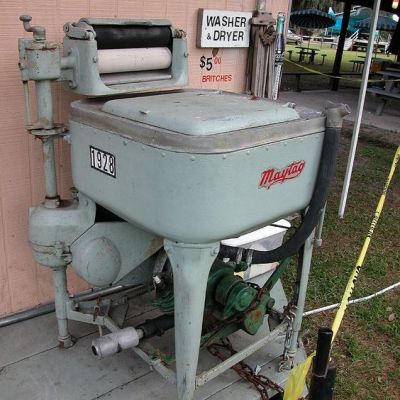 Using machines to wash and dry laundry isn’t a new concept. Washers and dryers have become commonplace enough that we don’t think of them as robots. Hamilton Smith patented the rotary washing machine in 1858. Maytag has had home machines available for nearly 100 years. Many of the early machines were powered by gasoline engines, as electricity wasn’t common in rural farmhouses. Things have improved quite a bit since then! From the dryer we transfer our laundry to a basket, where it has to be folded. It is this final step that cries out for a homemaking automaton to take this chore out of Everyman’s hands.
Using machines to wash and dry laundry isn’t a new concept. Washers and dryers have become commonplace enough that we don’t think of them as robots. Hamilton Smith patented the rotary washing machine in 1858. Maytag has had home machines available for nearly 100 years. Many of the early machines were powered by gasoline engines, as electricity wasn’t common in rural farmhouses. Things have improved quite a bit since then! From the dryer we transfer our laundry to a basket, where it has to be folded. It is this final step that cries out for a homemaking automaton to take this chore out of Everyman’s hands.
As one can imagine, folding laundry is one of those tasks that is easy for humans, but hard for robots. However, it’s not impossible. The idea of this article is to show what has been done, and get people talking. A project like this would take a person or group of people with skills in mechanics, electronics, machine vision, and software. It would also be sure to place well in the 2016 Hackaday Prize.
Continue reading “The Challenges Of A Laundry Folding Robot”
Shoot Darts At The Shins Of Total Strangers
[Michael Brumlow] found us and sent us a link. Within a few seconds, we were driving a webcam-enabled Nerf dart tank through his office and trying not to hit walls or get stepped on by his co-workers. Unfortunately, it was out of darts at the time, but you can find them all over the floor if you scout around.
 All of the code details, including the link where you can test drive it yourself, are up on [Michael]’s GitHub. The brains are an Intel Edison board, and the brawns are supplied by an Arduino motor controller shield and (for the latest version) a chassis bought from China.
All of the code details, including the link where you can test drive it yourself, are up on [Michael]’s GitHub. The brains are an Intel Edison board, and the brawns are supplied by an Arduino motor controller shield and (for the latest version) a chassis bought from China.
It runs fairly smoothly, considering the long round trip from [Michael]’s office in Texas, through wherever Amazon keeps their Web Services, over to us in Germany and back. Once we got used to the slight lag, and started using the keyboard’s arrow keys for control, we were driving around like a pro.
It’s got a few glitches still, like the camera periodically overheating and running out of WiFi distance. [Michael] said he’d try to keep it charged up and running while you give it a shot. The controls are multiplexed in the cloud, so your chance of steering it is as good as anyone else’s. It’ll be interesting to see what happens when thousands of Hackaday readers try to control it at once!
It takes a certain kind of bravery to put your telepresence robot up on the open Internets. So kudos to you, [Michael], and we hope that you manage to get some work done this week, even though you will have all of Hackaday driving into your cubicle walls.
Cute, Hackable, 3D Printable Robot Family
We first saw the robot Zowi (top row in the banner photo) at Make Munich a few weeks ago, and we were very impressed by how much interesting motion they were getting out of the ‘bot for only using four servo motors. The combination of big feet, strong ankle joints, and clever programming let the cute little bot stand on one leg, do a moonwalk, and even hop. (See the video, below the break.) We knew it was for sale. What we didn’t know is that it was entirely open source.
[Javier Isabel], the inventor, is very good at giving credit where it’s due, and that’s a great thing because his ‘bot is basically an improved BOB robot. That said, you really need to see this thing moving to know what a difference Zowi’s significantly stronger servos and clever programming can make.
But that’s not all! Since everything about Zowi is open, and up on GitHub you can not only 3D print one of your own, but you can easily modify the attractively-boxy case. And a handful of people have taken [Javier] up on the offer, and submitted their modifications back as pull requests. So if you’d rather something mildly more humanoid, and are willing to add a couple more servos, there’s a good basis for your explorations ready to go.
We really like the idea of collaborative toy-robot design, and from what we’ve seen the basic Zowi platform is a winner. Check it out and see if you’re not inspired to add your own personal touch to the design. If you do, be sure to contribute back for others to see!
Thanks [Nils Hitze] for the tip!
Continue reading “Cute, Hackable, 3D Printable Robot Family”

